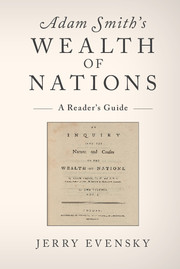Book contents
- Frontmatter
- Contents
- Acknowledgments
- Prologue: The Purpose of This Work
- 1 Adam Smith's Moral Philosophical Vision: The Context of His Economic Analysis
- 2 The Wealth of Nations: Book I
- 3 The Wealth of Nations: Books II and III
- 4 The Wealth of Nations: Book IV
- 5 The Wealth of Nations: Book V
- Epilogue: Adam Smith and Laissez-Faire
- References
- Index
1 - Adam Smith's Moral Philosophical Vision: The Context of His Economic Analysis
Published online by Cambridge University Press: 05 September 2015
- Frontmatter
- Contents
- Acknowledgments
- Prologue: The Purpose of This Work
- 1 Adam Smith's Moral Philosophical Vision: The Context of His Economic Analysis
- 2 The Wealth of Nations: Book I
- 3 The Wealth of Nations: Books II and III
- 4 The Wealth of Nations: Book IV
- 5 The Wealth of Nations: Book V
- Epilogue: Adam Smith and Laissez-Faire
- References
- Index
Summary
ADAM SMITH AS MORAL PHILOSOPHER
Philosophy, by representing the invisible chains which bind together all these disjointed objects, endeavours to introduce order into this chaos of jarring and discordant appearances, to allay the tumult of the imagination, and to restore it, when it surveys the great revolutions of the universe, to that tone of tranquility and composure, which is both most agreeable in itself, and most suitable to its nature. Philosophy, therefore, may be regarded as one of those arts which addresses themselves to the imagination. Adam Smith's History of Astronomy (hereafter HA) (45–6)
Adam Smith was a philosopher, one who believed that there is an order underlying what we observe in our universe and that to imagine and represent those “concealed connections that unite the various appearances of nature” (HA, 51) is an intellectual joy, an emotional balm, and a social benefit.
In his day philosophy was divided into two domains: Natural and Moral Philosophy.
Natural Philosophy focused on the physical universe. Natural philosophers carefully observed the universe and imagined what invisible connecting principles would be consistent with the “jarring and discordant appearances” we observe. Why, for example, do a few stars appear to wander through the heavens among the multitude of fixed stars?
For centuries successively more complex epicycles of explanation seemed to offer ever more accurate explanations of these wandering stars. Each “success” encouraged even more careful observation. But keen observation brought not more understanding – just more epicycles. Then the earth was moved by Copernicus from the center of the “universe” and, with the benefit of Kepler's elliptical orbits, a much simpler and more coherent explanation of the motion of these “wandering stars,” the planets, was achieved.
But if the earth is indeed spinning on its axis and orbiting around the sun, why don't we feel a brutal wind? If we speed along in a carriage the wind is in our face, and yet as we hurtle around the sun – no wind. This and other questions remained unanswered. Enter Newton.
- Type
- Chapter
- Information
- Adam Smith's Wealth of NationsA Reader's Guide, pp. 7 - 16Publisher: Cambridge University PressPrint publication year: 2015



